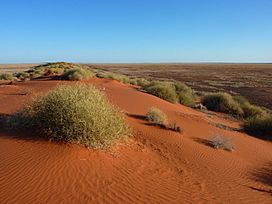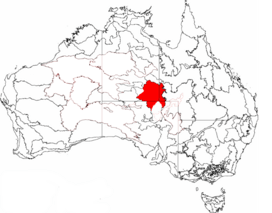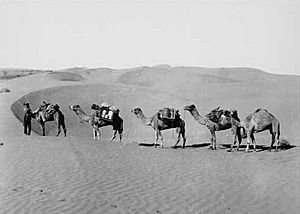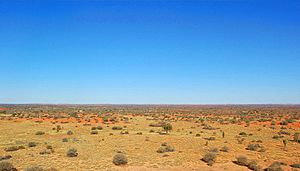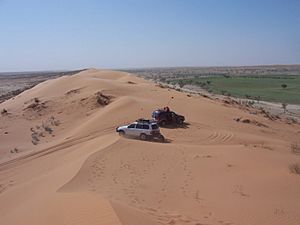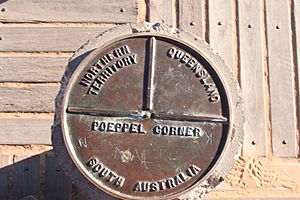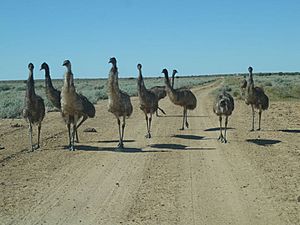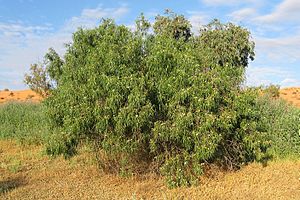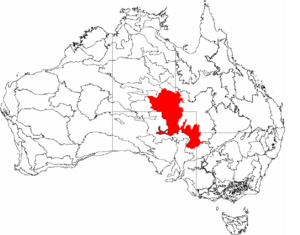Simpson Desert facts for kids
The Simpson Desert is a very dry part of Australia. It is mainly in the Northern Territory, but also in the north of South Australia and western Queensland. It covers about 176,500 square km, about 2.3% of Australia. The Simpson Desert gets less than 150 ml of rain each year. It is made up of big red sand dunes up to 40 m (44 yd) high, 190 km (118 mi) long and about 1 km (1 mi) apart. At most times there is no surface water, but after rain there can be rivers which flow into normally dry lakes. Temperatures in summer can be more than 50 C, and in winter can be below 0 C.
Early explorers into the Simpson Desert were Charles Sturt 1845, J.McKinlay, W.O. Hodgkinson, C.Winneke 1883, A.Poeppel 1879. The desert was named after A.A.Simpson, President of the Royal Geographical Society of Australasia in 1929. The first European to cross the desert was Ted Colson in 1936.
No proper roads cross the desert. There are many tracks that were made during the search for gas and oil during the 1960s and 1970s. These tracks include the French Line, the Rig Road, and the QAA Line. Such tracks can be driven on by well-equipped four-wheel drive vehicles which must carry extra fuel and water.
Towns close to the edge of the Simpson Desert include Oodnadatta to the southwest, and Birdsville in the east. On the western side is the Mount Dare hotel and shop. Before 1980, part of the Commonwealth Railways Central Australian line passed along the western side of the Simpson Desert. Within the Simpson people go to see the ruins at Dalhousie Springs, Purnie Bore wetlands, Approdinna Attora Knoll and Poeppel Corner (where Queensland, South Australia and Northern Territory meet).
Contents
History
Aboriginal history
Aboriginal people have lived in the Simpson Desert for at least 5000 years and continue to do so today. The Wangkangurru people lived in the Simpson Desert using hand-dug wells called mikiri from long before European colonization until the Federation Drought.
Post-colonisation
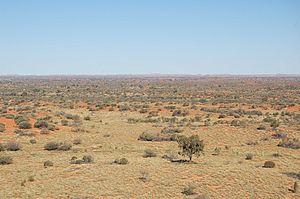
Explorer Charles Sturt, who visited the region from 1844 to 1846, was the first European to see the desert. In 1880, Augustus Poeppel, a surveyor with the South Australian Survey Department, determined the border between Queensland and South Australia to the west of Haddon Corner, and in doing so, marked the corner point where the States of Queensland and South Australia meet the Northern Territory. After he returned to Adelaide, the links in his surveyor's chain were found to have been stretched. Poeppel's border post was too far west by 300 m. In 1884, surveyor Larry Wells moved the post to its proper position on the eastern bank of Lake Poeppel. The tristate border is now known as Poeppel Corner. In January 1886, surveyor David Lindsay ventured into the desert from the western edge, in the process discovering and documenting, with the help of a Wangkangurru Aboriginal man, 9 native wells, and travelling as far east as the Queensland/Northern Territory border.
In 1936, Ted Colson became the first nonindigenous person to cross the desert in its entirety, riding camels. The name Simpson Desert was coined by Cecil Madigan, after Alfred Allen Simpson, an Australian industrialist, philanthropist, and geographer, and president of the South Australian branch of the Royal Geographical Society of Australasia. Mr Simpson was the owner of the Simpson washing machine company.
In September 1962, geologist Reg Sprigg, his wife Griselda, and their two children completed the first vehicular crossing of the desert.
In 1980, Bob Beer became the first person to run across the Simpson. Beer ran 420 km across the desert in 6.5 days, starting at Alka Seltzer Bore, South Australia and finishing at Birdsville, Queensland. A documentary was made about this trip called “The Runner”.
In 1984, Dennis Bartel was the first white man to successfully walk solo and unsupported west-to-east across the Simpson, 390 km in 24 days, relying on old Aboriginal wells for water. In 2006, Lucas Trihey was the first nonindigenous person to walk across the desert through the geographical centre away from vehicle tracks and unsupported. He carried all his equipment in a two-wheeled cart, and crossed from East Bore on the western edge of the desert to Birdsville in the east. In 2008, Michael Giacometti completed the first, and only, east-to-west walk across the Simpson Desert. Starting at Bedourie in Queensland, he walked solo and unsupported, towing all his equipment, food, and water in a two-wheeled cart to Old Andado homestead. Also in 2008, Belgian Louis-Philippe Loncke became the first non-indigenous person to complete a north–south crossing of the desert on foot, unsupported, and through the geographical centre.
In 2016, explorer Sebastian Copeland and partner Mark George completed the longest unsupported latitudinal crossing (west-to-east across the dunes) of the Simpson They linked the Madigan Line, Colson Track and French Line for the first time, walking from Old Andado homestead to Birdsville, a distance of 650 km (404 mi) in 26 days.
In 1967, the Queensland government established the Munga-Thirri National Park, formerly known as the Simpson Desert National Park.
Visitor attractions
The desert is popular with tourists, particularly in winter, and popular landmarks include the ruins and mound springs at Dalhousie Springs, Purnie Bore wetlands, Approdinna Attora Knoll and Poeppel Corner (where Queensland, South Australia and the Northern Territory meet). Because of the excessive heat and inadequately experienced drivers attempting to access the desert in the past, the Department of Environment and Natural Resources has decided since 2008–2009 to close the Simpson Desert during the summer – to save unprepared "adventurers" from themselves.
Another attraction is the Big Red Bash, which is billed as the most remote music festival on Earth. The event features concerts and a Big Red Bash drag race across sand dunes to raise money for the Royal Flying Doctor Service of Australia.
The desert can also be crossed by bicycle. The Simpson Desert Bike Challenge crosses the Simpson Desert every year in September.
Climate
The area has an extremely hot, dry desert climate. Rainfall is minimal, averaging only about 150 mm per year and falling mainly in summer. Temperatures in summer can approach 50 °C and large sand storms are common. Winters are generally cool, but heatwaves even in the middle of July are not unheard of.
Some of the heaviest rain in decades occurred during 2009–2010, and caused the Simpson Desert to burst into life and colour. In early March 2010, Birdsville recorded more rain in 24 hours than is usual in a whole year. Rain inundated Queensland's north-west and Gulf regions. In total, 17 million megalitres of water entered the State's western river systems, leading to Lake Eyre. In 2010, researchers uncovered the courses of ancient river systems under the desert.
Ecology
The flora of the Simpson Desert ecoregion is limited to drought-resistant shrubs and grasses, especially Zygochloa paradoxa grass that holds the dunes together and the spinifex and other tough grasses of side slopes and sandy desert floor between the dunes.
Wildlife adapted to this hot, dry environment and seasonal flooding includes the water-holding frog (Litoria platycephala) and a number of reptiles that inhabit the desert grasses. Endemic mammals of the desert include the kowari (Dasycercus byrnei), while birds include the grey grasswren (Amytornis barbatus) and Eyrean grasswren (Amytornis goyderi). Lake Eyre and the other seasonal wetlands are important habitats for fish and birds, especially as a breeding ground for waterbirds, while the rivers are home to birds, bats, and frogs. The seasonal wetlands of the ecoregion include Lake Eyre and the Coongie Lakes, as well as the swamps that emerge when Cooper Creek, Strzelecki Creek, and the Diamantina River are in flood. The birds that use these wetlands include the freckled duck (Stictonetta naevosa), musk duck (Biziura lobata), silver gull (Larus novaehollandiae), Australian pelican (Pelecanus conspicillatus), great egret (Ardea alba), glossy ibis (Plegadis falcinellus), and banded stilt (Cladorhynchus leucocephalus). Also, the mound springs of the Great Artesian Basin are important habitat for a number of plants, fish, snails, and other invertebrates.
Native vegetation is largely intact as the desert is uninhabitable, so habitats are not threatened by agriculture, but are damaged by introduced species, particularly rabbits and feral camels. The only human activity in the desert proper has been the construction of the gas pipelines, while the country on its fringes has been used for cattle grazing and contains towns such as Innamincka. Mound springs and other waterholes are vulnerable to overuse and damage. Protected areas of the ecoregion include the Simpson Desert, Goneaway, Lochern, Bladensburg, Witjira and Kati Thanda-Lake Eyre National Parks as well as the Innamincka Regional Reserve, and the Munga-Thirri–Simpson Desert National Park.
Images for kids
-
Simpson Desert visible dune lines and Lake Eyre at bottom left
See also
 In Spanish: Desierto de Simpson para niños
In Spanish: Desierto de Simpson para niños
 | William Lucy |
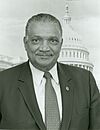 | Charles Hayes |
 | Cleveland Robinson |


